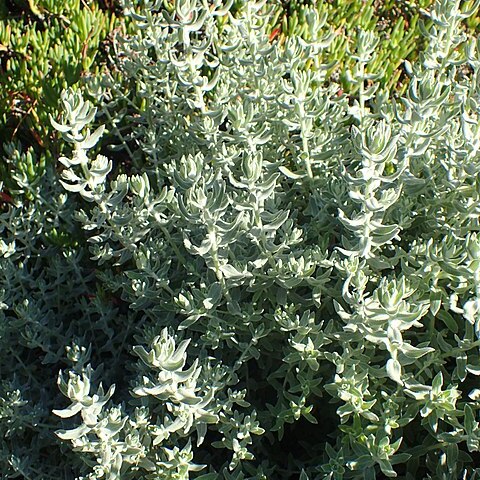Shrub or subshrub, erect to ±1 m, or sprawling or straggling, branches long, thin, greyish-white woolly, long spreading hairs as well, these sometimes rufous, leafy, flowering twigs more distantly so. Leaves mostly 6-30 x 2.5-10 mm, becoming smaller below the heads, elliptic, oblong or oblong-lanceolate, sessile, apex obtuse or subacute, mucronate, sometimes recurved, margins subrevolute, often undulate, thinly greyish-white woolly above or wool sometimes wanting, long spreading hairs as well, whitish or rufous, thickly woolly below, also with spreading hairs. Heads heterogamous, campanulate, ±4 x 3 mm, many in compact terminal corymbose panicles. Involucral bracts in 4-5 series, imbricate, graded, just overtopping flowers, silky-villous dorsally, outer lanceolate, often dark-tipped, inner oblong, tips rounded, glabrous, semi-opaque, pale straw-yellow, minutely radiating. Receptacle with fimbrils much exceeding the ovaries. Flowers 17-28, 3-10 female, occasionally with staminodes, 12-24 homogamous. Achenes ±0.75 mm, those from homogamous flowers often ± one third smaller, barrel-shaped, obscurely ribbed, in female flowers with duplex hairs, not myxogenic, in homogamous flowers usually glabrous, very rarely hairy. Pappus bristles many, equalling corolla, barbellate, bases lightly fused as well as cohering by patent cilia.
More
Subshrub, hairs patent, up to 1 m high, erect, sprawling, stems thin, greyish white-woolly, leafy. Leaves 6-30 x 2.5-10.0 mm, elliptic to oblong-lanceolate, apex ± obtuse, mucronate, margins ± revolute, undulate, ± greyish white-woolly above, thickly woolly below. Capitula heterogamous, campanulate, 4 x 3 mm, many in corymbose panicles; involucral bracts in 4 or 5 series, graded, outer lanceolate, often dark-tipped, inner oblong, glabrous, pale straw-yellow. Receptacle fimbrils exceeding ovaries. Flowers 17-28. Flowering time Sept.-Nov. Pappus of many bristles, equalling corolla, barbellate, bases cohering by patent cilia. Cypselae ± 0.75 mm long, from bisexual flowers often 1/3 smaller, barrel-shaped, glabrous, ± ribbed, from female flowers with duplex hairs.
Like H. hebelepis but stems and bracts with silky, spreading, often rufous hairs as well as woolly hairs.
Like H. hebelepis but with silky, spreading, often rufous hairs as well as woolly hairs.

